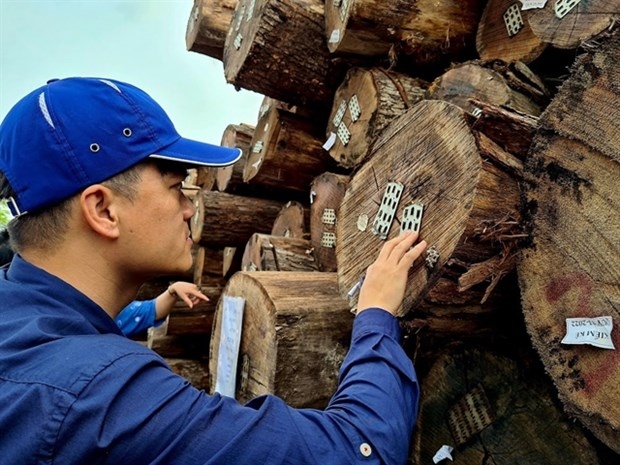Huge potential for Vietnam’s timber exports
Due to the ongoing conflict in Ukraine, and many European countries turning their back on the supply of gas from Russia, the export potential of wood, and especially wood pellets, is on an upward trend.
According to the Association of Vietnam Timber and Forest Products (Viforest), in 2021, the total export value of Vietnam's wood and wood products totalled US$14.8 billion. In particular, the United States is a large market for Vietnam's wood industry, accounting for about 60% of its total export turnover. Vietnam is also the second highest importer of wood from the US, after China.
Wood pellets, commonly made of raw materials such as wood chips, sawdust, shavings, bark, crop straw, and other biomass materials, are becoming a billion-dollar industry with no export tax, according to insiders. Such pellets are now a promising choice as a form of fuel.
However, certification on quality, origin and sustainability is a prerequisite to tapping into this lucrative market.
A forest with sustainable community development is among the criteria for the Forest Stewardship Council Certificate (FSC), and this certificate helps Vietnamese firms access more global markets.
Ngo Sy Hoai, deputy head of Viforest, said “Many people in the EU are switching to wood pellets as fuel for the coming winter,” adding that Vietnam, as the world's second-largest exporter of the material, has an advantage, as the export price of pellets has increased by more than 27% compared to 2021.
A report titled "Vietnam's production and export of pellets: Current situation and some policy aspects" has just been published by Forest Trends in collaboration with Viforest, revealing that although Vietnam is not a major supplier of pellets to EU countries, the increasing demand and price in the international market creates opportunities for Vietnam’s pellet industry to expand production and export.
An expert from Forest Trends, To Xuan Phuc, told local media that pellets have only been around for around 10 years, but the growth in export value has been very fast. In 2018, the export of pellets increased by 67% in volume and 120% in value over the previous year, marking an export value of more than US$362 million.
In 2021, the export turnover from pellets reached US$413 million and in the first 6 months of 2022, Vietnam exported 67.33% of the total volume of pellets compared to 2021.
"EU countries turned their backs on gas from Russia when the Russia-Ukraine conflict broke out, leading to imported pellets being used to replace this lost supply. Demand and price of pellets in the EU increased sharply, creating attraction from large suppliers, especially from the US - the largest exporter of such material,” Phuc said.
According to the Ministry of Industry and Trade, the export value of wood and wood products in the first nine months of 2022 was estimated at US$12.4 billion, up 11.4% year-on-year. Of which, the figure for wood products was US$8.6 billion, up 2.4%. Wooden furniture has always been the main export item in the structure of wood products for export.
The Ministry of Industry and Trade also considers pellets a bright spot for the wood industry as the demand and export prices in the international market increase, creating opportunities for production and export. The price of pellets exported to the EU has doubled from US$100 per tonne to around US$200 at the end of 2021.
Viforest says that if the growth rate is maintained, the export turnover of wood pellets in the whole of 2022 could reach around US$700 million, adding they are likely to enter the group of agro-forestry products with an export turnover of over US$1 billion.
With an annual growth rate of 30-40% in the last ten years, total export turnover of wood and wood products will reach US$14.72 billion, putting Vietnam in the top five exporters after China, Poland, Germany and Italy. The wood industry strives to reach an export turnover of US$20 billion by 2025.
Despite the strong potential, firms exporting timber to the EU need to have FSC certificates, which can cost thousands of dollars and require many procedures for a batch of products. In this case, the Voluntary Partnership Agreement between Vietnam and the European Union (EU) on forestry law enforcement, forest governance and trade in forest products, or the VPA/FLEGT "green passport", provides long-term benefits.
Last week, the Organisation for Cooperation and Development Germany (GIZ) in collaboration with the General Department of Forestry of Vietnam organized a seminar on the value chain of forest products and the implementation of the VPA/FLEGT Agreement.
Luu Tien Dat, from the General Department of Forestry, said after more than ten years, the agreement aims to ensure that Vietnam’s wood products are legally produced, contributing to improving forest governance and expanding markets, as well as promoting the trade in sustainable wood and wood products.
Nguyen Tuong Van, vice president of the Vietnam Forestry Science and Technology Association, said that although the VPA/FLEGT agreement has not had much of an impact on timber exports to the EU, it benefited wood furniture exports to the much bigger market of the US.
With its own law on timber trade, the US after seeing Vietnam negotiated and implemented the VPA Agreement with the EU, it is considered a "passport" for local wood to enter the market, adding Vietnam’s wood export turnover to the US accounts for 58% of total wood product exports.
Hoai from Viforest says that over the years, enterprises exporting wood and wood products to the EU must provide many types of documents to prove the legality and origin of raw wood to the EU authorities, while with the FLEGT license, they don’t need any other paperwork.
He said that enterprises must comply with all regulations on labour and environment, social insurance, and supply chain management. With that, the new ‘FLEGT Green Passports’ will allow businesses to accelerate market expansion in the EU as well as around the world."

